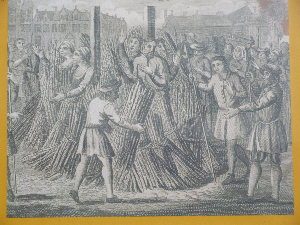London is one of the most beautiful, and powerful cities on Earth with a mixed and fascinating 2000-year history. I work in one small corner of the City, on Holborn Circus, and within a 20min walk I can visit some charming, historical and interesting places. I am going to show you a few of them. I shall measure all distances from Holborn Circus.
In Smithfield Garden, close to the church of St Bartholmew the Great, is a particularly gruesome reminder of what we used to do to protect the State, in this case against Protestantism. In the reign of Queen Mary, Elizabeth’s elder sister, it was the practice to try, and then execute, citizens for their religious beliefs. The method of execution was to tie a group of them to stakes, surround them with bunches of dried sticks, and then set fire to the whole thing. These were referred to as “The fires of Smithfield” and they drew a cheery, noisy crowd. Go down to Smithfield Garden and see the monument to “The martyrs of Smithfield.”
You can see a more extensive list of these unfortunate citizens in the church of St James, Clerkenwell. As you enter the church look for a large black board leaning against a wall on your right. The names in gold on the board are some of the 200 or so people whom Queen Mary executed by burning during the 1550s. The illustration, below, is on a board in the Smithfield meat market.
Just 10m away you’ll see the monument to Sir William Wallace who was also executed in Smithfield Garden, this time by being hanged, drawn and quartered. For some time his head was displayed on a pike on London Bridge. Don’t believe the ending of the movie “Braveheart”; this was a horrible torture lasting at least four hours, during which an expert executioner would keep the prisoner alive until the very last.
Henry VIII, below, gave a warrant to St Bartholomew the Less to allow it to be the only church in London to have a hospital as its exclusive parish – and still does. He is standing, using his favoured Holbein pose, in the gate to the church of St Bartholomew the Less, and you wouldn’t know there was a nice little church unless you first of all wondered why Henry is there, and go exploring the short lane behind the gate. In the church are memorials to nurses and surgeons.
Nearby is Cloth Fair. Sir John Bettjemen used to live here, and numbers 41 and 42 are said to be the oldest lived-in houses in London, being built close to 1600. In Medieval times, on St Bartholomew’s Day there was a cloth fair associated with healing and miracles in the church of St Bartholomew the Great. All kinds of cloth were traded, but eventually, the stalls of other traders and a large amount of entertainment on offer led to a 2-week party called St Bartholomew Fair. This became so rowdy and even violent, it was finally legislated against in the 1850s and closed down.
Smithfield is now just a quiet little backwater with St Bart’s Hospital, a beautiful old church and the silent, Victorian buildings of Smithfield Market. And, of course, a lovely little park and garden called Smithfield Garden with the essential Victorian statue exhorting you to lead the Good Life, and on sunny days, a small crowd of local workers enjoying their lunch.
Here is a quirky little place in Smithfield. On the door is written Last Passage, above the door is the street sign East Passage, and the address for the Old Red Cow is Back Passage. The sign on the window says it was one of the earliest Ancient Taverns in Smithfield. Bernard Miles and Peter Ustinov frequented the pub and the landlord’s hot toddy was a secret substance in a ginger wine base. I’ll bet you can’t find it!








